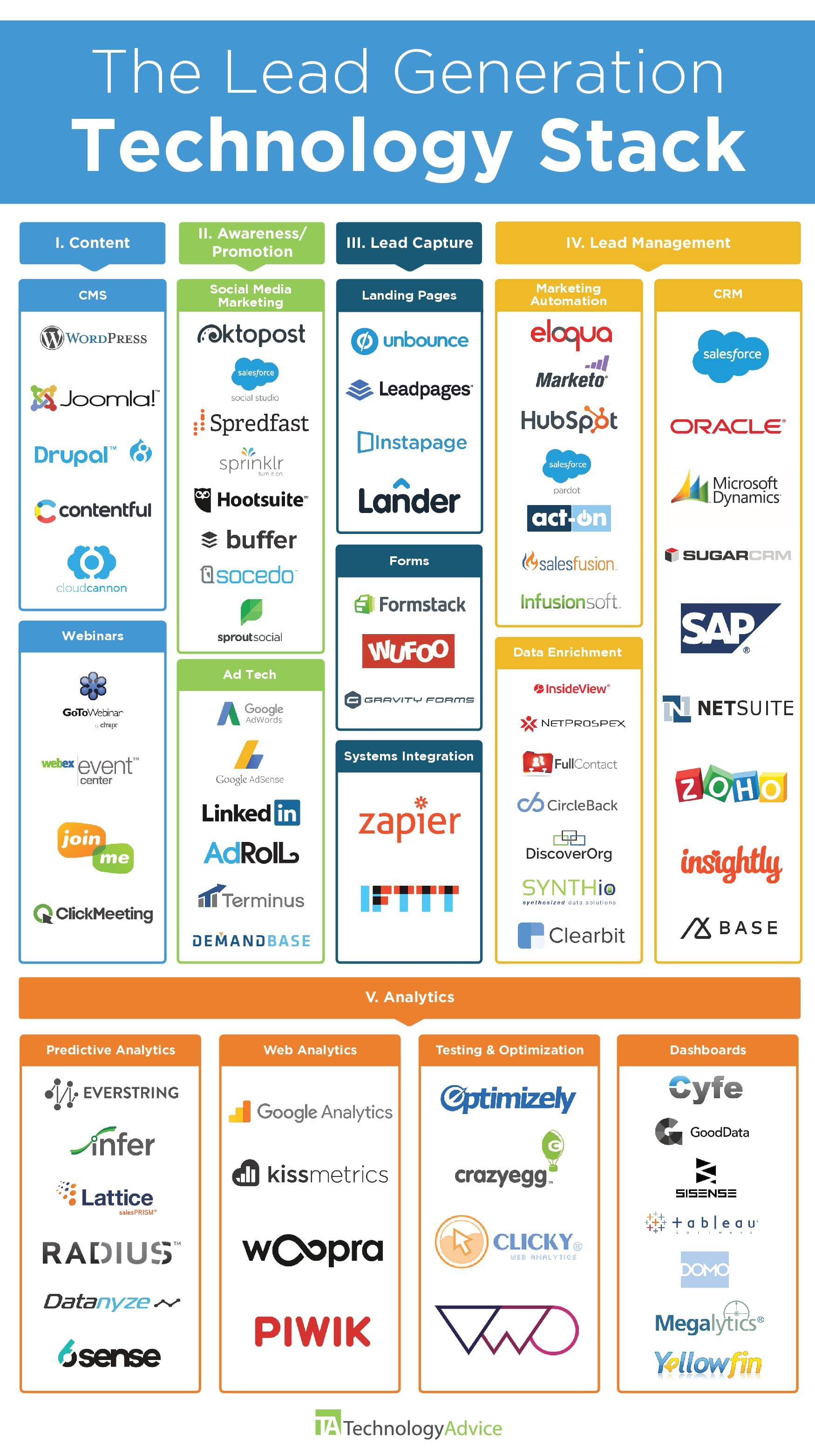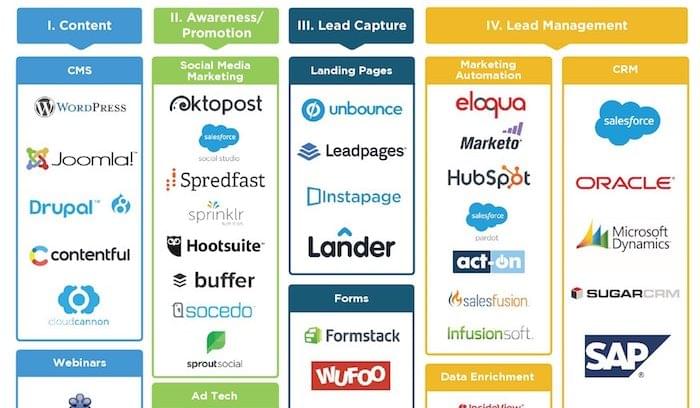Conceptually, lead generation is simple: attract prospects, offer something of value, and capture contact information.
Of course, if you’re a demand gen marketer, you know the process is much more challenging and resource-intensive. For starters, there’s the complexity of running simultaneous campaigns across multiple channels — search, social, mobile, email, etc. You also must contend with content creation, landing pages, targeting strategies, paid syndication, performance analytics, and pressure from sales to meet quality and quantity quotas.
A survey from August, unsurprisingly, found that improving lead quality and adding new customers were the top two goals for most B2B marketers.
In practice, lead generation is more like conducting an orchestra than a simple, transactional exchange. If you want to succeed, you need to have both the sheet music (strategy) and the instruments (technology) — not one or the other.
The good news is that most marketers have no problem spending money on technology. According to Gartner’s CMO Spend Survey for 2015-2016, marketing technology accounts for 33 percent of the average department’s budget. The bad news is that a lot of us still don’t know which of the now 3,800+ “martech” solutions to spend our money on.
The answer will depend on what your firm sells, to whom you sell it, and how you’re trying to market (duh, I know). That means neither TechnologyAdvice nor any other research agency can in good conscience provide a breakdown of the tools EVERY B2B marketing team should purchase to fulfill ALL of their needs. But what we can do is address a specific segment of the martech landscape: lead generation.

If you’re trying to figure out what software you need in order to attract and capture qualified leads, you’re building a lead generation technology stack. In the section below, we’ll take a look at eight tools every demand gen marketer should have in their stack and list the top vendors in each category. The selections are based on current best practices as well as our own experience with B2B marketing and lead generation.
We apologize in advance for throwing another “stack” onto the already insurmountable stack of stacks in the B2B world, but this one is different; you do legitimately need these tools to be effective as a demand gen marketer.
I. The Essentials
Content Management
Content marketing is arguably the linchpin of lead generation. If you want people to volunteer their contact information, you have to give them something in return. More often than not, that “something” will be a piece of content. There are a number of different avenues for publishing and circulating lead generation content (third-party syndication among them). Regardless of which you pursue, you’ll need a way to post and manage assets on your website.
That might include an industry blog, a research library, case studies, pricing guides, frequently asked questions, or all of the above. The key here is to pick something that lets marketing users access and edit content on a regular basis without needing help from engineers. If you have the necessary resources, your Dev team might decide to build a custom solution into the backend of your site. Otherwise, you can use an off-the-shelf content management system (CMS).
> Leading CMS Providers
Some marketing automation vendors — like HubSpot, for example — provide website and content management features built into their platform. This can be an easy way to kill two birds with one stone, but it depends what kind of website you want to build. Dedicated CMS platforms tend to offer deeper customization and better scalability.
Landing Pages and Forms
Landing pages are ground zero for prospect-to-lead conversion. After traveling in through a link from one of your various marketing channels, prospects must decide whether or not to abide your call to action. In the context of lead generation, that usually means submitting their contact and firmographic information through a web form — name, email address, business name, industry, location, etc. According to a 2012 benchmark study by HubSpot, B2B companies with 40 or more landing pages generate five times more leads than companies with only a few.

In addition to helping you capture leads, landing pages are a critical component in marketing analytics, serving as a medium through which you can track conversion rates and lead source. Using UTM codes and reporting tools build into your web form/landing page software, you can see not only which channel, but which specific campaign, generated each lead.
Common features of landing page software include templates, dynamic content, email and CRM integration, A/B testing, and reporting. Some landing page tools include web forms as a feature, while others are sold as standalone products. Marketing automation platforms often include all of the above.
> Landing Pages
> Web Forms
Marketing Automation
A marketing automation platform (MAP) is one of the most important tools in the lead generation stack. That’s partly because of its broad range of features (a MAP helps you orchestrate multichannel campaigns and track ROI) and partly because of its lead management capabilities (lead nurturing, scoring, segmentation, and analysis). MAPs are also great at identifying prospects and logging their behavior across your digital properties. Since somewhere between 57 and 90 percent of B2B site visitors are anonymous, that’s a big deal.
If you don’t use a marketing automation platform, your ability to capitalize on generated leads will be severely limited. This is especially true in cases where a marketing team buys in bulk from a third-party provider. Purchased leads should meet an agreed-upon standard for quality and engagement, but they will still need to be nurtured through at least the first couple stages of the purchase process before speaking directly with sales.
For more information on the features and capabilities of marketing automation software, check out our buyer’s guide.
> Leading Marketing Automation Vendors
CRM Software
CRM software is basically a database for storing customer information and moving leads through the sales process. It bears about as much importance as a marketing automation platform, but the main user group, in this case, will be sales. After connecting your web forms to your CRM, you can automatically save each entry as a new lead. If the case of third-party programs, many lead gen providers can deliver leads through an API, so you won’t have to manually import long lists.
The real magic (and the real utility) of a CRM is its ability to sync with marketing automation software. That integration gives your marketing team the ability to update leads as they progress through the pipeline and mark them as sales-ready when it’s time to reach out. It also supports closed-loop analytics, so you can track which leads generate revenue and how long that takes. As of 2014, Nucleus Research reported that the average CRM investments, on average, returned $8.71 for every dollar spent.
To learn more about CRM features and capabilities, check out our buyer’s guide.
> Leading CRM Providers
Social Media Marketing
There are hundreds of different social media management tools on the market — some designed for basic content sharing, others for deeper “listening” and analysis. And yes, there are tools designed to help you find and generate leads from social channels. These are often referred to as “social prospecting” or “social selling” tools.
If you haven’t broken into the world of social lead generation, you’re missing out on an opportunity to engage your buyers during a critical stage of the purchase process. According to 2015 data from Demand Gen Report, 53 percent of B2B buyers say that social media plays a role in their evaluation of different tools and technologies.
And of course, there’s the added benefit of increasing brand awareness and expanding your content reach. Even if you don’t identify sales-ready leads, social marketing combined with a regularly-updated blog is a perfect one-two punch for attracting site visitors and connecting with new prospects.
Common social media marketing software features include social listening, content queues and scheduling, MAP/CRM integration, and analytics.
> Leading providers:
II. Ancillary Lead Generation Tools
If you want to succeed with lead generation in the digital age, you really can’t live without a CMS, CRM, and marketing automation platform. Depending on what features your MAP provides out-of-the-box, you may also need a landing page builder and a social media marketing tool.
The solutions we’ve covered so far are non-negotiable components of your lead generation stack, but they aren’t the only tools you’ll use. Depending on what campaigns you run and how much visibility you require, there are a number of ancillary tools that can help you amplify success or a gain better understanding of your market.
Ad Tech
From traditional, pay-per-click networks to social media, retargeting, and account-specific platforms, these solutions give you the ability to supplement organic traffic with paid advertising and increase traffic at the top of the funnel.
Top Vendors:
- Google AdWords
- AdSense
- AdRoll
- Terminus (account-based)
- Demandbase (account-based)
Webinar Software
Webinars are an incredibly effective lead generation tool, especially when you extend attendance to the “on-demand” audience. You can certainly build signup pages using your MAP or landing page tool, but you’ll need something else to run the webinar itself.
Top Vendors:
- GoToWebinar (by GoToMeeting)
- WebEx Event Center
- Highfive
- ClickMeeting
Web Analytics and Testing
Tools in this category will help you identify anonymous prospects, monitor engagement with your digital content, and test different configurations to see which one yields the best conversion rate. Web analytics is also the secret ingredient in lead scoring. If your current MAP doesn’t offer these as built-in features, consider a standalone solution.
Top Vendors:
- Google Analytics
- Kissmetrics
- Crazy Egg (heatmapping)
- Clicky
* * *
Keep in mind, technology is only half of the picture. The challenge of lead generation is not just targeting, scaling, and automating your campaigns through the latest software; it’s also about crafting messages and “brand experiences” (genuinely sorry for using that phrase) that effectively communicate value. For that, it helps to start with a solid product in the first place and point to a slew of positive reviews from happy customers.
Make it all work together, and you’ll maintain the lead volume and lead quality necessary to grow your business. Isn’t that what we all want?

